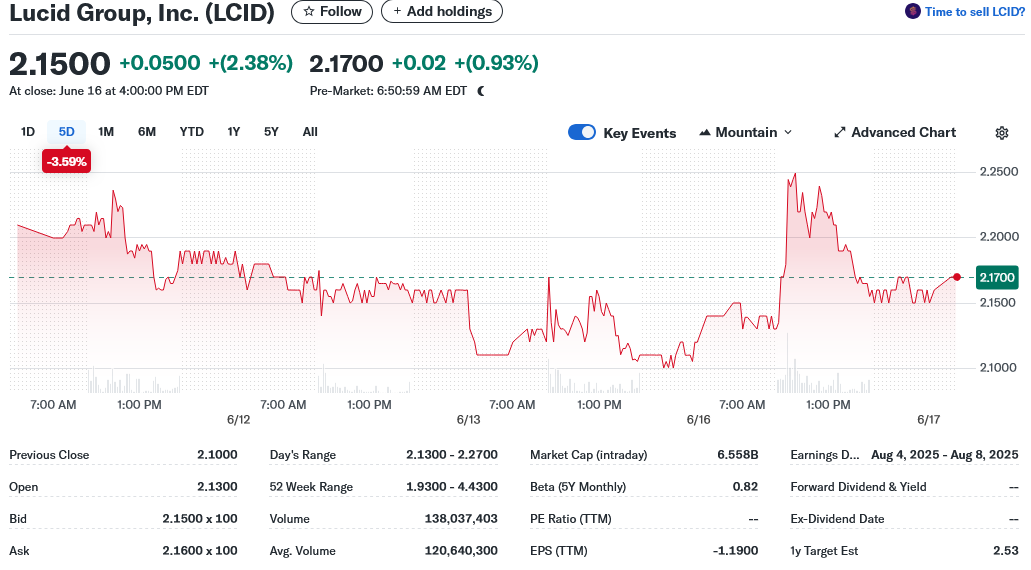TLDR
- Lucid Group (LCID) stock down 30% in 2025, trading at $2.15 with potential catalysts ahead
- Company planning to unveil three affordable vehicles under $50,000 in late 2026 to compete with Tesla
- New Gravity SUV showing promise with 75% of orders from new customers, despite slow initial rollout
- Q1 2025 delivered 3,109 vehicles (58% increase) with revenue up 36% to $235 million
- Faces headwinds from declining EV interest (16% vs 23% in 2023) and high luxury pricing starting at $70,000
Lucid Group has had a rough 2025. The electric vehicle maker’s stock has dropped 30% since January, currently trading at $2.15. But two potential catalysts could change everything when the company reports earnings in August.
The first catalyst centers on Lucid’s upcoming affordable vehicle lineup. The company plans to unveil three new mid-sized vehicles priced under $50,000 in late 2026. This would mark the first time Lucid’s EVs become accessible to mass market buyers.
Current CEO Marc Winterhoff expressed optimism about these models during last quarter’s call. “I was just down in the design studio, and I can tell you the vehicles look amazing,” he said. The company plans to unveil them late this year or early next year.
Former CEO Peter Rawlinson called the mass market vehicles a “landmark product.” He believes they will finally allow Lucid to “compete directly with Tesla.” Tesla’s success story provides a roadmap here.
Tesla remained a niche luxury brand until launching the Model 3 and Model Y. These affordable models now account for over 90% of Tesla’s vehicle sales. Other EV makers are following this playbook, with Rivian planning three vehicles under $50,000 by early 2026.

Production Ramp and Market Positioning
Lucid faces challenges scaling up manufacturing for these new models. The company will likely need additional capital to expand production capabilities. But any positive updates in August could provide the stock a much-needed boost.
The second catalyst involves the Gravity SUV platform launched earlier this year. Despite initial software glitches, the vehicle is attracting both loyal customers and newcomers. Three-quarters of Gravity orders come from customers new to the Lucid brand.
Analysts expect major growth from Gravity sales. They project 73% sales growth in 2025, followed by another 96% jump in 2026. Nearly all this growth stems from anticipated Gravity momentum.
The Gravity competes directly with Tesla’s Model X. Tesla sells roughly 4,000 Model X vehicles per quarter. Lucid sold only 50 Gravity vehicles last quarter, leaving substantial room for growth.
Recent Performance Metrics
Lucid showed positive momentum in Q1 2025. The company delivered 3,109 vehicles, representing a 58% increase from the previous year. Revenue climbed 36% to $235 million during the same period.
Management projects doubling vehicle production from last year to reach 20,000 vehicles by 2025. This ambitious target could drive share price gains if achieved. The company also plans to launch the Lucid Earth, a midsize SUV starting around $48,000 in 2026 or 2027.
However, Lucid faces headwinds in the current market. American consumer interest in electric vehicles has declined from 23% in 2023 to 16% currently, according to AAA. This trend likely reflects rising vehicle costs over recent years.
Lucid’s luxury positioning creates additional challenges. The company’s lowest-priced Air sedan costs 43% more than the average new vehicle transaction price. All current models start around $70,000, pricing out many potential buyers.
Management warned that automotive tariffs could hurt gross margins by 8% to 15%. This pressure might force price increases to offset rising costs. The Trump administration’s potential pullback on EV tax credits and charging infrastructure adds another concern.
The stock has fallen 96% from its all-time high of $58 reached in 2021. While some investors hope for a recovery to previous levels, the path forward remains challenging. Lucid must successfully ramp production, launch new models, and increase sales while lowering costs in a cautious EV market.


